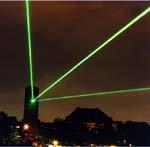LiDaR
LIDAR - LIght Detecting And Ranging

Fot. source: KS
The simplest LIDAR type is the aerosol LIDAR. Its principle of operation relays on ubiquitous phenomenon of light scattering on molecules and other particulates suspended in atmospheric air. A light pulse generated typically by a laser is sent into the atmosphere and its "optical echo", a so called LIDAR signal, is next registered as a function of time delay between the pulse release moment and its return to the detector. The decay of light intensity is used for retrieving scattering properties of atmospheric aerosols like extinction or backscattering coefficients. Precise global quantities of these two important parameters are still unknown, making the radiative forcing of atmospheric aerosols a topic of an ongoing scientific discussion.If instead of single wavelength several wavelengths are sent simultaneously another important parameter of aerosol, namely the size distribution of its particles, can be determined. The LIDAR working on this principle is called the multiwavelength LIDAR. Inversion of multiwavelength LIDAR signals is from mathematical point of view an ill-posed problem. It requires sophisticated numerical tools such as discretization and regularization.
LIDAR can also provide information on the state of aggregate of scattering objects. Liquid particles consisting of water and water soluble substances like: sulfates, nitrates, and many organic particles tend to form microdroplets, which do not change polarization of backscattered light. This is explained by their spherical symmetry, which does not favour any particular electric field direction. An irregular shape of water insoluble dusts or other mineral matter strongly affects polarization of scattered light. The LIDAR working on the light depolarization principle is called the depolarization LIDAR. It measures the backscattered intensity in two perpendicular polarization channels, one parallel and the other perpendicular to the laser polarization, allowing distinction between solid and liquid aerosol.
Despite a success in atmospheric sciences the LIDAR technique is limited by an assumption on extinction-to-back scatterer ratio (extinction coefficient divided by backscattering coefficient). To overcome this inconvenience an inelastic Raman scattering LIDAR has been proposed. Raman LIDAR is sensitive to scattering on selectively chosen, typically nitrogen or oxygen, molecules. Since scattering particles are a priori known the inversion of the lidar signal becomes straightforward. One must solve a simple exponential equation with a single unknown.
In our group all mentioned above LIDAR types are continuously developed. They have been operated in many field campaigns.